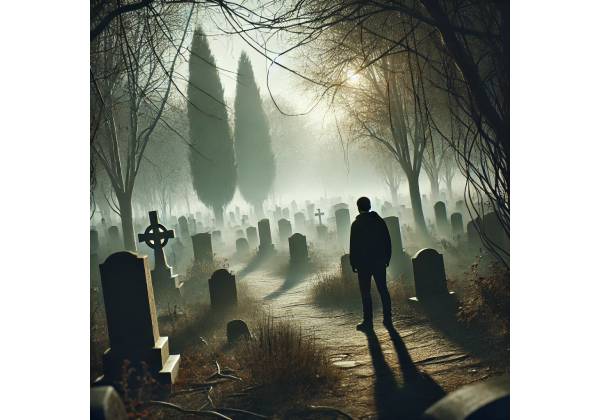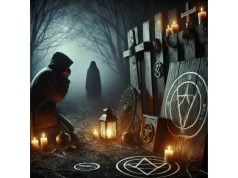
What is necrophobia?
Necrophobia is a phobia defined by an intense, irrational fear of death or dead things, such as dead bodies, funerals, and death-related objects like coffins or graves. People suffering from necrophobia experience overwhelming and debilitating fear of death, which has a significant impact on their daily lives. While it is natural to feel uncomfortable or sad when thinking about death, people who have necrophobia experience a disproportionate level of fear, which interferes with their ability to function in certain environments or situations.
Necrophobia can be caused by a variety of factors, including seeing a dead body, visiting a cemetery, or hearing death-related news. Individuals suffering from this phobia may exhibit extreme physical, emotional, and behavioral responses, causing them to avoid funerals, hospitals, and any situation that reminds them of death. This avoidance can be isolating and difficult because it frequently conflicts with societal norms and expectations regarding mourning or caregiving.
For those suffering from necrophobia, the condition is more than just a fear of their own mortality; it is a generalized fear of death and everything associated with it. Addressing this phobia is critical for improving mental health and well-being, and with the right treatment, people can overcome their fears and reclaim control of their lives.
Common Symptoms of Necrophobia
Necrophobia can present in a variety of ways, ranging from mild anxiety to full-blown panic attacks. These symptoms can be triggered by encounters with deceased people, funerals, or even just the thought of death. Recognizing the symptoms is the first step toward better understanding and treating this phobia. Below, we will look at the physical, emotional, and behavioral symptoms of necrophobia.
Physical Symptoms
Physical symptoms of necrophobia are frequently similar to those of panic attacks and other anxiety disorders. These symptoms can appear when the individual is exposed to death-related stimuli or even thinks about death. Typical physical symptoms include:
- Rapid heartbeat (tachycardia): When confronted with death-related triggers, people suffering from necrophobia may experience a sudden increase in heart rate, which is frequently accompanied by a sense of impending death.
- Shortness of breath or hyperventilation: Fear of death can cause people to breathe quickly, resulting in hyperventilation, a sense of being out of breath, or feelings of suffocation.
- Dizziness or lightheadedness: Necrophobia can cause people to feel faint or dizzy, especially if their anxiety is extremely high. This may be exacerbated in settings such as hospitals or funeral homes.
- Sweating and shaking: Anxiety associated with necrophobia frequently results in excessive sweating, especially when the individual believes they are confronting their fear of death directly. During these intense moments of fear, you may also experience trembling or shaking.
- Chest pain or tightness: Many people with necrophobia experience pressure or pain in their chest during anxiety attacks, which can be alarming and contribute to further panic.
- Nausea or upset stomach: The intense fear experienced during a necrophobic episode may cause gastrointestinal symptoms such as nausea, stomach cramps, or vomiting.
Emotional and cognitive symptoms
Necrophobia has a significant emotional and cognitive impact, often resulting in constant anxiety and intrusive thoughts about death. The emotional and mental toll can be exhausting, as people are frequently preoccupied with fears that they struggle to control or rationalize. Some of the emotional and cognitive symptoms are:
- Overwhelming fear or panic attacks: When confronted with death-related stimuli, people with necrophobia may experience intense fear that can progress to a panic attack, which is characterized by extreme anxiety, difficulty breathing, and a sense of loss of control.
Individuals with necrophobia may experience recurring, intrusive thoughts about death, dying, or dead bodies. These thoughts can be upsetting and difficult to control, causing significant emotional turmoil.
- Irrational beliefs about death: People who suffer from necrophobia may develop irrational fears about death, such as believing that they will die prematurely or that being near a dead body will cause harm or illness. These beliefs can exacerbate the phobia and make it more difficult to deal with death-related situations.
- Feelings of helplessness or hopelessness: Many people with necrophobia are overcome by their fear, believing they can’t escape or control it. This sense of helplessness can lead to feelings of despair or hopelessness, especially if the phobia interferes with daily activities.
- Catastrophic thinking: People with necrophobia may engage in catastrophic thinking, which involves imagining the worst-case scenarios for death and dying. This can include fears of their own death, the death of loved ones, or intense phobias of funerals or cemeteries.
Behavioral Symptoms
Necrophobia frequently results in significant behavioral changes as people attempt to avoid situations that trigger their fear. These avoidance behaviors can cause problems in personal, social, and professional life. Typical behavioral symptoms include:
- Avoiding funerals, cemeteries, or hospitals: Many people with necrophobia make an effort to avoid places associated with death, such as funerals, cemeteries, or hospitals. This avoidance can lead to feelings of isolation, especially if social expectations compel them to attend these events.
- Refusing to talk about death: People with necrophobia may avoid discussing death, even if it is relevant to the situation. This avoidance can be difficult in relationships where death is a necessary topic of discussion, such as when making plans for the future or dealing with loss.
- Avoiding death-related media or literature: Necrophobia can lead to people avoiding books, movies, or news stories about death or dying. This aversion can spread to entire genres of entertainment, such as horror films or crime shows, in which death is a common theme.
- Compulsive rituals or behaviors to “ward off” death: In some cases, people suffering from necrophobia develop compulsive behaviors or rituals to protect themselves from death. These behaviors are similar to those seen in obsessive-compulsive disorder (OCD) and may include repetitive actions like checking vital signs or avoiding numbers or symbols associated with death.
Understanding these symptoms is critical for identifying necrophobia and recognizing how it affects a person’s daily life. Once these symptoms are identified, people can seek help and look into treatment options to help them cope with their fears.
What causes necrophobia?Exploring the Origins and Risk Factors
Necrophobia, like other phobias, is thought to arise from a combination of genetic, psychological, and environmental factors. The exact cause of necrophobia varies from person to person, but several shared origins and risk factors may contribute to the development of this intense fear of death and dead things.
Traumatic Experiences
A previous traumatic experience with death is a significant risk factor for the development of necrophobia. This could include witnessing a loved one’s death, attending a funeral or burial, or being involved in a potentially fatal illness or accident. These events can create a strong association between death and fear, causing the individual to develop necrophobia as a coping mechanism for the trauma.
A single traumatic experience, such as the unexpected death of a family member, may be enough to cause necrophobia in some people. Others may develop a phobia after being repeatedly exposed to death-related situations, such as working in a healthcare setting.
Cultural And Religious Beliefs
Cultural and religious beliefs about death can also influence the development of necrophobia. Many cultures regard death as a taboo subject, and discussions about dying are avoided or deemed inappropriate. These cultural attitudes can contribute to the development of fear by teaching people to associate death with negative emotions such as sadness, fear, or danger.
Religious beliefs about the afterlife, judgment, and punishment can all contribute to necrophobia. For example, individuals raised in religious environments where death is associated with eternal punishment or judgment may develop an overwhelming fear of death as a result of these teachings.
Learned Behavior and Conditioning
Phobias can be acquired through observation or direct experience, particularly in childhood. If a child sees a parent or caregiver express fear or anxiety about death, they may internalize these feelings and develop necrophobia themselves. Furthermore, if a person has been conditioned to associate death with negative experiences, such as seeing frequent depictions of death in the media or being taught to avoid discussing death, they may develop a stronger fear of it.
Pre-existing Anxiety Disorders
People who have pre-existing anxiety disorders, such as generalized anxiety disorder (GAD) or panic disorder, may be more likely to develop necrophobia. The increased anxiety associated with these disorders can cause people to become more focused on their fears of death or dying. In some cases, necrophobia may be a symptom of larger anxiety issues, in which death becomes the primary focus of the individual’s fears.
Genetic Predisposition
There is evidence that phobias, including necrophobia, may have a genetic basis. Individuals with a family history of anxiety disorders or specific phobias may be more predisposed to developing necrophobia themselves. While genetics do not cause phobias, they can increase an individual’s susceptibility to developing anxiety-related conditions when exposed to certain environmental triggers.
How Is Necrophobia Diagnosed?
A licensed mental health professional, such as a psychologist or psychiatrist, will usually diagnose necrophobia using clinical interviews and standardized diagnostic criteria. The purpose of the diagnosis is to distinguish necrophobia from other anxiety disorders and to ensure that the individual receives the best possible treatment.
Clinical Interview and Symptom Assessment
During the diagnostic process, the mental health professional will conduct a thorough clinical interview to learn about the person’s fear of death and how it affects their daily life. The clinician will look into the origins of the phobia, its specific triggers (such as funerals, dead bodies, or discussions about death), and any associated emotional or physical symptoms. The interview may also delve into the individual’s personal history, such as previous traumatic experiences with death or cultural beliefs that may contribute to their fear.
Diagnostic Criteria
Necrophobia is diagnosed according to the criteria for specific phobias outlined in the Diagnostic and Statistical Manual of Mental Disorders (DSM-5). The DSM-5 requires the following criteria for a diagnosis of necrophobia:
- Extreme fear or anxiety about death, dying, or dead bodies that outweighs the actual threat posed by these stimuli.
- The phobia causes significant distress or impairment in social, occupational, or other areas of functioning for the individual.
- The fear is persistent, often lasting six months or more.
- No other mental health disorder, such as generalized anxiety disorder (GAD) or post-traumatic stress disorder (PTSD), can better explain the fear or anxiety response.
Psychological Assessments
In some cases, clinicians may use standardized psychological assessments or questionnaires to determine the severity of the phobia. These tools assist individuals in quantifying their level of fear, avoidance behaviors, and the impact of the phobia on their quality of life. Instruments such as the Fear Survey Schedule and the Specific Phobia Scale can help determine the extent of an individual’s necrophobia and guide the development of a personalized treatment plan.
Differential Diagnosis
It is critical to distinguish necrophobia from other mental health conditions that may exhibit similar symptoms. Individuals suffering from health anxiety (hypochondria) may also be afraid of death, but their anxiety is focused on illness and bodily symptoms rather than the death itself. Similarly, people suffering from PTSD may have a fear of death as a result of past trauma, but this fear is usually based on specific experiences rather than a general fear of death. Accurate diagnosis ensures that the patient receives the best treatment for their specific condition.
Treating Necrophobia: Therapies and Interventions
Treating necrophobia usually entails a combination of psychological therapies, lifestyle changes, and, in some cases, medication. The goal of treatment is to reduce the fear response associated with death while also assisting individuals in developing healthier ways of thinking about and dealing with death-related stimuli. Below, we will look at some of the most effective necrophobia treatment options.
Cognitive-Behavioral Therapy (CBT)
Cognitive Behavioral Therapy (CBT) is a highly effective treatment for necrophobia. Individuals can use CBT to identify and challenge negative thought patterns and irrational beliefs that contribute to their fear of death. Working with a therapist can help people reframe their thoughts about death and develop more balanced, realistic perspectives.
cognitive restructuring is a key technique used in CBT, which involves assisting the individual in recognizing irrational fears and replacing them with more rational thoughts. For example, a necrophobic person may have an irrational fear that being near a cemetery will cause harm or death. Through cognitive restructuring, the therapist assists the individual in challenging this belief by investigating the actual risk involved and providing evidence to the contrary.
Exposure Therapy
Exposure therapy is a type of behavior therapy that is extremely effective in treating certain phobias, including necrophobia. This method involves gradually and methodically exposing the individual to death-related stimuli in a controlled and safe setting. The goal of exposure therapy is to desensitize the individual to their fear, allowing them to face death-related situations without feeling overwhelmed with anxiety.
During exposure therapy, the individual may begin with less anxiety-provoking tasks, such as discussing death in a therapy session or viewing images of cemeteries and funerals. As they gain confidence, the therapist may introduce more challenging exposures, such as visiting a cemetery or attending a funeral. Repeated exposure gradually reduces the fear response, allowing the individual to cope with death-related situations more effectively.
Virtual reality exposure therapy (VRET)
Virtual Reality Exposure Therapy (VRET) is a novel treatment that uses virtual reality technology to simulate death-related scenarios, allowing people to confront their fears in a safe and controlled virtual environment. This method can be especially beneficial for people who are not yet prepared for real-world exposure to death-related stimuli, such as visiting a cemetery or attending a funeral.
VRET allows individuals to practice confronting their fears in a gradual and controlled manner, which helps to reduce anxiety over time. VRET has been shown in studies to be an effective treatment for specific phobias, including necrophobia, by providing immersive exposure in a safe environment.
Mindfulness and Relaxation Techniques
Mindfulness-based therapies, such as Mindfulness-Based Stress Reduction (MBSR), can help people with necrophobia manage their anxiety by teaching them to be present in the moment and reduce their tendency to overthink death-related events. Deep breathing exercises, meditation, and progressive muscle relaxation can all help to calm the nervous system and keep anxiety at bay when confronted with death-related stimuli.
Individuals suffering from necrophobia can practice mindfulness to learn to observe their thoughts and emotions without becoming overwhelmed by them. This is especially useful for reducing the intensity of the fear response and allowing people to better tolerate anxiety-provoking situations.
Hypnotherapy
Hypnotherapy is another treatment option that can help some people with necrophobia. During hypnotherapy sessions, the individual is guided into a deeply relaxed state that allows them to be more open to suggestions. The therapist may use this state to address the individual’s underlying fears and beliefs about death, as well as to introduce positive suggestions to help reframe their thoughts.
While hypnotherapy is not a stand-alone treatment for necrophobia, it can be an effective addition to other therapeutic approaches, especially when combined with CBT or exposure therapy.
Medication
In some cases, medication may be prescribed to help manage the symptoms of necrophobia, particularly if the phobia is severe or co-occurs with other anxiety disorders. **Selective serotonin reuptake inhibitors (SSRIs), such as fluoxetine or sertraline, are commonly prescribed to reduce anxiety and improve mood, making it easier for people to participate in therapy.
Benzodiazepines, such as diazepam or lorazepam, can also be used to treat acute anxiety symptoms, such as panic attacks caused by death-related situations. However, because of the risk of dependency, these medications are typically used with caution and are prescribed in conjunction with therapy rather than as a long-term solution.
Support Groups and Peer Counseling
Individuals suffering from necrophobia may benefit from joining support groups. Individuals with similar fears can share their experiences in a group setting, learn from each other’s coping strategies, and offer mutual support. The ability to discuss fears and anxieties in a nonjudgmental setting can make people feel less isolated and more empowered to face their phobia.
Peer counseling or one-on-one support from people who have overcome their necrophobia can also help. These peer mentors can offer guidance, encouragement, and practical advice for dealing with death-related fear and anxiety.
Lifestyle Changes and Self-Help Strategies
In addition to formal therapy, making lifestyle changes and incorporating self-help strategies can help people with necrophobia better manage their symptoms. These strategies could include:
- Gradual exposure in everyday life: People can practice overcoming their fear of death in small, manageable steps. For example, watching a documentary about death or visiting a cemetery can be considered self-directed exposure.
- Journaling: Recording thoughts, fears, and progress in a journal can help people reflect on their phobia, identify patterns, and track their progress over time.
- Practicing relaxation techniques: Including stress-reduction practices like yoga, meditation, or breathing exercises in your daily routines can help manage general anxiety and make it easier to confront death-related fears.
Individuals suffering from necrophobia can gradually overcome their fear of death by combining therapy, medication (if necessary), and lifestyle changes.










